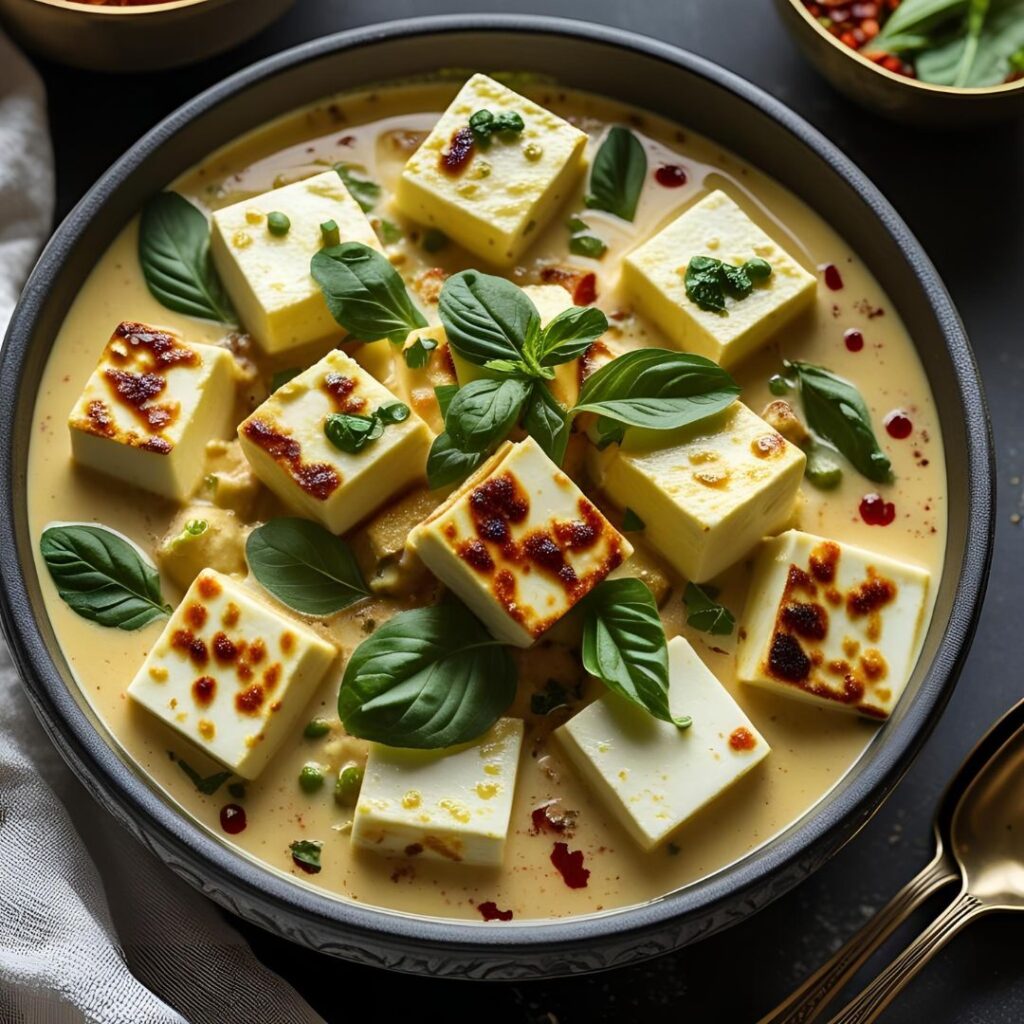

Malai Paneer Recipe: A Celebration of Creamy Elegance in Indian Cuisine. Indian cuisine is known for its bold flavors, diverse regional traditions, and complex spice profiles. But amid the heat and intensity of its masalas, there are also dishes that highlight gentler, subtler tastes—dishes that bring comfort and refinement in every bite. One such beloved preparation is Malai Paneer. This rich, creamy, and mildly spiced dish is a luxurious tribute to dairy, where paneer—the Indian cottage cheese—is cooked in a velvety white gravy infused with cream, milk, and aromatic spices. Unlike its fiery cousins like Paneer Tikka Masala or Kadhai Paneer, Malai Paneer offers a soothing, mellow experience, making it a standout in any vegetarian spread.
The word “Malai” in Hindi refers to clotted cream, a thick layer of cream that forms on top of boiled milk. In Indian households, malai is considered a delicacy in itself—used in desserts, spread on toast, or folded into gravies. Malai Paneer, then, is literally “paneer in cream,” and the dish does justice to its name. It is an ode to the dairy-loving culture of North India, especially Punjab and Uttar Pradesh, where milk, ghee, yogurt, and cream form the bedrock of many traditional meals.
Paneer, the primary ingredient in this dish, is a fresh, non-melting cheese made by curdling milk with a food acid like lemon juice or vinegar. Its mild taste and soft texture make it a versatile canvas for a variety of Indian preparations. In Malai Paneer, the cheese is bathed in a gravy that is light on spices but big on comfort and indulgence.
What sets Malai Paneer apart from other paneer dishes is its subtle flavor profile. Instead of relying on red chili, turmeric, or garam masala, the dish leans on ingredients like green cardamom, white pepper, fresh cream, milk, and cashews. The result is a pale, ivory-colored gravy that is mild in heat but incredibly rich in flavor and texture. It’s buttery, slightly sweet, and infused with gentle aromatics that don’t overpower the star ingredient—paneer.
This makes Malai Paneer especially appealing to those who prefer milder Indian food or are just being introduced to the cuisine. Its non-spicy nature makes it ideal for kids and those with sensitive palates, without sacrificing depth or satisfaction.
Malai Paneer may not have a well-documented royal origin like some Mughlai dishes, but its richness and refinement clearly reflect influences from Mughal and Awadhi cuisines. These culinary traditions are known for their use of dairy, nuts, and fragrant whole spices to create luxurious gravies and kebabs. The use of cashew and onion paste, cardamom, and cream in Malai Paneer mirrors the elegance of Mughlai cooking.
In fact, dishes like Shahi Paneer, Malai Kofta, and Paneer Pasanda share similar royal roots. What distinguishes Malai Paneer is its simplicity—fewer spices, no tomatoes, and a focus on achieving a clean, creamy base that lets the paneer shine.
One of the great things about Malai Paneer is how adaptable it is. While it is a traditional dish, it fits comfortably into modern lifestyles and diets. For home cooks, it’s a go-to choice for dinner parties, family gatherings, or festive meals. It pairs wonderfully with Indian breads like naan, tandoori roti, or lachha paratha, as well as with pulao or jeera rice.
In a professional kitchen or restaurant setting, Malai Paneer often finds a place on the menu as a rich vegetarian main course that contrasts beautifully with spicier offerings. Its delicate flavor also makes it an excellent companion for more complex dishes, providing a creamy counterpoint to balance out a full Indian thali or buffet.
Moreover, for those seeking lighter versions, Malai Paneer can be adapted by reducing the quantity of cream and butter, or by substituting dairy with plant-based alternatives like almond milk and cashew cream, making it a favorite among health-conscious and vegan food lovers alike.
As Indian cuisine has spread across the globe, paneer dishes have gained immense popularity. In particular, Malai Paneer is appreciated internationally for its mild flavor and creamy consistency. Western diners, sometimes hesitant about spicy food, often find it a perfect introduction to Indian flavors. It fits neatly into fusion recipes too—used as a filling for wraps, sandwiches, or even pasta with an Indian twist.
In fact, as the demand for vegetarian and protein-rich diets grows, dishes like Malai Paneer are becoming more than just traditional favorites—they’re also being recognized for their nutritional benefits. Paneer is a great source of protein and calcium, and when used in moderation, cream and milk provide healthy fats. The absence of heavy spices and oil also makes it easier on the digestive system.
While it’s undeniably rich, Malai Paneer isn’t limited to special occasions. Its relatively simple ingredient list and ease of preparation make it a weekday treat or weekend comfort food in many Indian households. It's one of those dishes that feels luxurious without requiring an extravagant effort. For novice cooks, it serves as an entry point into Indian cuisine; for seasoned chefs, it offers a blank canvas for customization and experimentation.
Add a few green peas for color, a hint of saffron for aroma, or even a touch of grated nutmeg for extra warmth—Malai Paneer welcomes creativity without compromising its identity.
There’s something inherently comforting about Malai Paneer. It brings together the familiar tastes of milk, cream, and soft cheese—ingredients many of us associate with home, warmth, and nourishment. In that sense, it goes beyond being just another curry. It’s a dish that feels like a hug in a bowl, one that evokes a sense of calm and satisfaction with every spoonful.
Its understated elegance allows it to transcend cultural and culinary boundaries. Whether you’re cooking it for a festival, a guest, or simply yourself, Malai Paneer is a reminder that richness doesn’t always come from heat or spice. Sometimes, it comes from restraint—from knowing when to hold back and let simple ingredients speak for themselves.
Malai Paneer is more than just a dish—it’s a culinary experience rooted in tradition, comfort, and elegance. It reflects the gentle side of Indian cuisine, one that embraces softness over sharpness, cream over spice, and depth over intensity. Whether served at an opulent celebration or a quiet family dinner, it brings with it a timeless charm that continues to win hearts across generations and geographies.
1. Prepare the White Gravy Paste (10 mins):
2. Cook the Gravy (15–20 mins):
3. Garnish and Serve:
Total Time Breakdown
Prep Time: 10 minutes
Cooking Time: 25 minutes
Total Time: 35 minutes
Servings: 4 persons
The quality of paneer can make or break your Malai Paneer. Since the dish has a subtle and creamy profile, the paneer itself becomes the centerpiece. Always try to use fresh, homemade paneer if possible. It’s softer, creamier, and absorbs the flavors of the gravy more effectively. If using store-bought paneer, soak it in warm water for 10–15 minutes before cooking. This rehydrates and softens it, preventing the rubbery texture that often results from refrigeration. Soft paneer melts in the mouth and pairs beautifully with the silky malai-based gravy, giving you the luscious, creamy experience the dish is known for.
Malai Paneer’s creamy white gravy often starts with a blended paste of boiled onions and cashews. This paste must be cooked thoroughly in butter or ghee to remove any raw smell and ensure a smooth, rich flavor. Under-cooked onion paste can give a slightly bitter or pungent aftertaste, ruining the delicacy of the dish. Cook it over medium heat until the fat begins to separate from the paste and it takes on a light cream color—usually about 7–10 minutes. This process deepens the flavor and creates a well-integrated base for the cream and milk to blend into, ensuring a harmonious gravy.
The hallmark of Malai Paneer is its mild, creamy flavor, so it’s important to resist the urge to over-spice it. Unlike dishes like Paneer Butter Masala or Kadhai Paneer, Malai Paneer uses minimal spices—typically just cardamom, white pepper, and bay leaf. Avoid red chili powder, turmeric, or heavy garam masala blends that can overpower the dish. A light hand allows the natural sweetness of cream, milk, and onions to shine through. Think of this dish as a gentle symphony of creamy, nutty, and aromatic notes, rather than a loud, spicy curry.
Fresh cream is the heart of Malai Paneer, and its richness defines the dish. However, cream is delicate and can curdle if boiled too long or added at high heat. To preserve its silky texture, always turn the heat to low or off before stirring in the cream. Let the dish simmer gently after the cream is added, but avoid aggressive boiling. You can even warm the cream slightly before adding it to the gravy to help it blend smoothly. This step ensures a luxuriously smooth consistency without any graininess or separation.
Malai Paneer benefits greatly from small flavor enhancements that add depth without dominating the dish. A tiny pinch of sugar (½ to 1 teaspoon) enhances the sweetness of the onions and balances the richness of the cream. In contrast, kasuri methi (dried fenugreek leaves) brings a faint bitterness and earthiness that cuts through the fat, creating a well-rounded flavor profile. Always crush the kasuri methi between your palms before adding it near the end of cooking to release its aroma. These two simple additions elevate the dish from creamy to truly gourmet.
Malai Paneer is a mildly spiced North Indian curry made with paneer (Indian cottage cheese) in a rich, creamy white gravy using milk, cream, cashews, and onions. While it may resemble Shahi Paneer in richness, it differs in flavor and color. Shahi Paneer usually includes tomatoes and more spices, resulting in a reddish-orange gravy, whereas Malai Paneer is paler and more subtly flavored.
You can use either. Homemade paneer is softer and fresher, which enhances the dish, but good-quality store-bought paneer works fine too. If using packaged paneer, soak it in warm water for 10–15 minutes before cooking to make it soft and moist.
No, Malai Paneer is not spicy. It’s one of the milder paneer curries, making it perfect for children and people with low spice tolerance. The dish uses minimal spices and gets its flavor from cream, cashews, and aromatic ingredients like cardamom and white pepper.
You can substitute fresh cream with:
These options reduce calories while maintaining the dish’s creamy texture.
Yes. You can prepare the gravy ahead of time and refrigerate it for 1–2 days. Add the paneer and cream just before serving to retain the best texture and avoid overcooking or curdling.
This usually happens when cream or milk is added at high heat. Always lower the flame or turn it off before adding cream, and stir gently. If using yogurt or cashew paste, make sure it’s blended well and added slowly while stirring.
It’s not ideal to freeze the finished dish, as cream and paneer both change texture after thawing. However, you can freeze the gravy base without cream or paneer. Thaw, reheat, then add fresh paneer and cream just before serving for the best results.
Malai Paneer pairs beautifully with:
Yes, Malai Paneer is very flexible. You can add:
To get that silky restaurant-style texture:
Malai Paneer Recipe: A Celebration of Creamy Elegance in Indian Cuisine. Indian cuisine is known for its bold flavors, diverse regional traditions, and complex spice profiles. But amid the heat and intensity of its masalas, there are also dishes that highlight gentler, subtler tastes—dishes that bring comfort and refinement in every bite. One such beloved preparation is Malai Paneer. This rich, creamy, and mildly spiced dish is a luxurious tribute to dairy, where paneer—the Indian cottage cheese—is cooked in a velvety white gravy infused with cream, milk, and aromatic spices.
Enjoy the yum :)